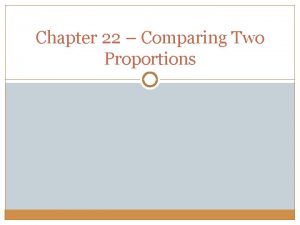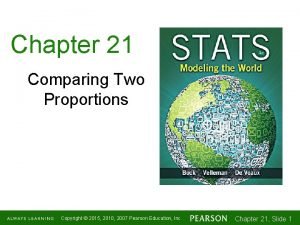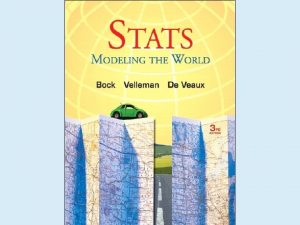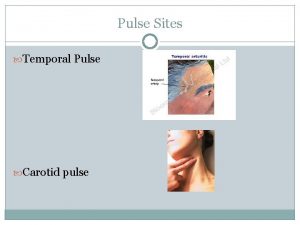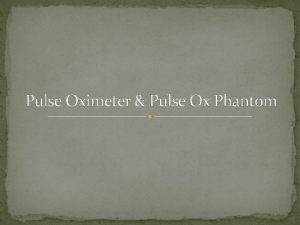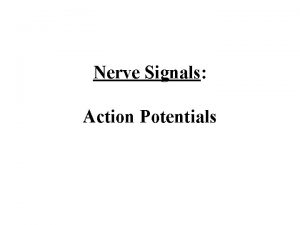CHAPTER 24 Comparing Means PART 2 Resting pulse







- Slides: 7

CHAPTER 24 Comparing Means PART 2

Resting pulse rates for a random sample of 26 smokers had a mean of 80 beats per minute and a standard deviation of 5 bpm. Among 32 randomly selected nonsmokers, the mean and standard deviation were 74 and 6 bpm. Both sets of data were roughly symmetric and had no outliers. Is there evidence of a difference in mean pulse rate between smokers and nonsmokers? If so, how big of a difference? Step 1: State hypotheses

Resting pulse rates for a random sample of 26 smokers had a mean of 80 beats per minute and a standard deviation of 5 bpm. Among 32 randomly selected nonsmokers, the mean and standard deviation were 74 and 6 bpm. Both sets of data were roughly symmetric and had no outliers. Is there evidence of a difference in mean pulse rate between smokers and nonsmokers? If so, how big of a difference? Step 2: Check conditions and model üSmokers are independent and nonsmokers are independent. üSmokers and nonsmokers were randomly sampled. üSmokers and nonsmokers are independent from one another. It is okay to proceed with a 2 -sample t-test. üIt is stated that the distributions are roughly symmetric.

Resting pulse rates for a random sample of 26 smokers had a mean of 80 beats per minute and a standard deviation of 5 bpm. Among 32 randomly selected nonsmokers, the mean and standard deviation were 74 and 6 bpm. Both sets of data were roughly symmetric and had no outliers. Is there evidence of a difference in mean pulse rate between smokers and nonsmokers? If so, how big of a difference? Step 3: Mechanics To get degrees of freedom: STAT TESTS 4: 2 -Samp. TTest t = 4. 15 P =. 000113 df = 56

Resting pulse rates for a random sample of 26 smokers had a mean of 80 beats per minute and a standard deviation of 5 bpm. Among 32 randomly selected nonsmokers, the mean and standard deviation were 74 and 6 bpm. Both sets of data were roughly symmetric and had no outliers. Is there evidence of a difference in mean pulse rate between smokers and nonsmokers? If so, how big of a difference? Step 4: Conclusion Because the P-value is so small, the observed difference in pulse rates is unlikely to be just sampling error. We reject the null hypothesis. We have strong evidence of a difference in mean pulse rates for smokers and nonsmokers.

Resting pulse rates for a random sample of 26 smokers had a mean of 80 beats per minute and a standard deviation of 5 bpm. Among 32 randomly selected nonsmokers, the mean and standard deviation were 74 and 6 bpm. Both sets of data were roughly symmetric and had no outliers. Is there evidence of a difference in mean pulse rate between smokers and nonsmokers? If so, how big of a difference? How big of a difference? Let’s use 95% confidence. We can be 95% confident that the average pulse rate for smokers is between 3. 1 and 8. 9 beats per minute higher than for nonsmokers.

Assignment for today: q Add to HW: p. 579 #4, 6, 9, 12, 17, 20 q Chapter 23 & 24 Homework due Monday q The following problem is due today. Here are the saturated fat contents (in grams) for several pizzas sold by two national chains. Do the two pizza chains have significantly different mean saturated fat contents? If so, provide a 95% confidence interval for the difference. Bran 17 12 d D 8 12 Bran 6 7 d 10 8 8 10 10 5 16 16 15 11 7 9 11 4 13 7 13 9 11 12 11 3
 Resting pulse rates for a random sample of 26
Resting pulse rates for a random sample of 26 Chapter 24 comparing means
Chapter 24 comparing means Comparing means in excel
Comparing means in excel Monitoring comparing and correcting work is part of
Monitoring comparing and correcting work is part of Chapter 22 comparing two proportions
Chapter 22 comparing two proportions Chapter 10 comparing two populations or groups answer key
Chapter 10 comparing two populations or groups answer key Ap stats chapter 21 comparing two proportions
Ap stats chapter 21 comparing two proportions Understanding and comparing distributions
Understanding and comparing distributions




